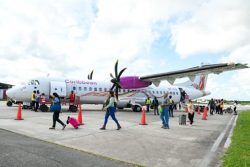(Trinidad Guardian) – An earthquake of 4.7 magnitude at a depth of 40km shook parts of north Trinidad on Sunday. Acting director of the Seismic Research Centre of the University of the West Indies, Dr Joan Latchman confirmed the report yesterday stating that there was neither damage nor injury. It was felt from Carenage in the northwest, to Moruga on the south central coast, to Matura on the northeast coast.
The quake occurred about 15 miles northwest of Port-of-Spain; 70 miles west southwest of Scarborough, Tobago; and 90 miles south of St George’s Grenada, at a depth of about 36.9 miles. But Latchman noted that an earthquake of 4.7 could bring a house down depending on how far it was from the house. This one, she said, happened away from the built-up areas, so there was no damage. Meanwhile, the Office of Disaster Preparedness and Management (ODPM) said in a release yesterday that the first responder agencies had been put on alert to render assistance in the event of any aftershocks.
It said the Disaster Management units within the various municipal corporations would continue to perform damage assessments throughout the country with assistance from the ODPM.
The ODPM said if citizens had been affected, they should contact their municipal corporation or the ODPM at 800-6376. But Latchman explain-ed that this recent earthquake was part of a series of earthquakes that began on September 29, 2006 that registered a magnitude of 5.8—the highest registered on land in Trinidad–since they have been monitoring earthquakes with their instruments.
Recounting that event, she said, on that same day and in the same general area, the country had 11 earthquakes and the biggest aftershock five hours later with a magnitude of 5.3.
“The following day there were eight earthquakes located and on the third day, the number dropped to four,” Latchman said. She further explained that the number of earthquakes for this area fell off very rapidly until the intervals between the earthquakes got longer with one or two occurring every month or two.
Since that she said, the country had an earthquake on February 23rd, 2007 with a 4.7 magnitude. The other one occurred on November 11, 2008 with a magnitude of 4.3 and the most recent on Sunday December 27, 2010—a 4.7 magnitude.
She explained that earthquakes follow a certain balance or ratio and they observed that T&T did not experience all the earthquakes as expected. However, Latchman said, “We may still see an earthquake larger than 4.7, but if its an aftershock, it’s not expected to be larger than 5.8 in magnitude.” “This, however, does not discount the possibility that the activity that we have seen in this area is all precursory to something bigger than 5.8,” she added.
She said since this is the first sequence of earthquakes they have in their database from a monitoring process since 1952, they had nothing with which to compare it in order to assess its development. “But the data we have at this time suggests that we are seeing aftershocks,” she said. However, Latchman advised citizens to visit their Web site at www.uwiseismic.com
and take note of the recommendations and try to implement them.





